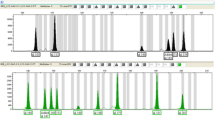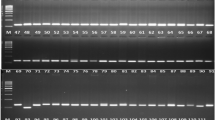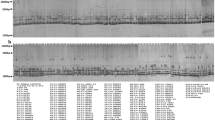Abstract
The aim of this study was to analyze the genetic similarity in commercial cultivars of sugarcane from the breeding program cultivars RB (Republic of Brazil), using SSR markers and coefficient of parentage. Eighteen microsatellite markers were used to estimate genetic similarity in 30 genotypes and coefficient of parentage was estimated in 28 accessions. Eighteen primer pairs produced an average of 3.2 alleles, the level of polymorphism (PIC value) ranged from 0.34 to 0.78 in SMC248CG and SCC2 primers, respectively. The parentage coefficient was high among cultivars, with a mean of 0.14, suggesting high relationship among the cultivars. The results here suggest that to analyzed accessions, there is a high genetic similarity which could reduce the genetic gain in breeding. However, crosses among genotypes of sugarcane produce a high variability in the progenies, suggesting a combination between the genomes of species that originated the current cultivars.
Similar content being viewed by others
References
Agarwal M, Shrivastava N, Padh H (2008). Advances in molecular marker techniques and their applications in plant sciences. Plant Cell Reports 27: 617–631.
Alwala S, Kimbeng CA, Gravois KA, Bischoff KP (2006). TRAP, a new tool for sugarcane breeding comparison with AFLP and coefficient of parentage. Journal American Society Sugar Cane Technologists 26: 62–86.
Benson G (1999). Tandem repeats finder: a program to analyze DNA sequences. Nucleic Acids Research 27: 573–580.
Bielig LM, Mariani A, Berding N (2003). Cytological studies of 2n male gamete formation in sugarcane, Saccharum L. Euphytica 133: 117–124.
Corbellini M, Perenzin M, Accerbi M, Vaccino P, Borghi B (2002). Genetic diversity in bread wheat, as revealed by coefficient of parentage and molecular markers, and its relationship to hybrid performance. Euphytica 123: 273–285.
Cordeiro GM, Casu R, McIntyre CL, Manners JM, Henry RJ (2001). Microsatellite markers from sugarcane (Saccharum spp.) ESTs cross transferable to erianthus and sorghum. Plant Science 160: 1115–1123.
Cordeiro GM, Pan YB, Henry RJ (2003). Sugarcane microsatellites for the assessment of genetic diversity in sugarcane germplasm. Plant Science 165: 181–189.
Cordeiro GM, Taylor GO, Henry RJ (2000). Characterisation of microsatellite markers from sugarcane (Saccharum sp.), a highly polyploid species. Plant Science 155: 161–168.
Coto O, Cornide MT, Calvo D, Canales E, D’Hont A, Prada F (2002). Genetic diversity among wild sugarcane germplasm from Laos revealed with markers. Euphytica 123: 121–130.
Cox TS, Lookhart GL, Walker DE, Harrell LG, Albers LD, Rodgers DM (1985). Genetic-relationships among hard red winter-wheat cultivars as evaluated by pedigree analysis and gliadin polyacrylamide-gel electrophoretic patterns. Crop Science 25: 1058–1063.
D’hont A, Grivet L, Feldmann P, Rao S, Berding N, Glaszmann JC (1996). Characterisation of the double genome structure of modern sugarcane cultivars (Saccharum spp) by molecular cytogenetics. Molecular & General Genetics 250: 405–413.
Ek M, Eklund M, Von Post R, Dayteg C, Henriksson T, Weibull P, Ceplitis A, Isaac P, Tuvesson S (2005). Microsatellite markers for powdery mildew resistance in pea (Pisum sativum L.). Hereditas 142: 86–91.
Glynn NC, Mccorkle K, Comstock C (2009). Diversity among mainland USA sugarcane cultivars examined by SSR genotyping. Journal of the American Society of Sugar Cane Technologists 29: 36–52.
Grivet L, Arruda P (2002). Sugarcane genomics: depicting the complex genome of an important tropical crop. Current Opinion in Plant Biology 5: 122–127.
Kumpatla SP, Mukhopadhyay S (2005). Mining and survey of simple sequence repeats in expressed sequence tags of dicotyledonous species. Genome 48: 985–998.
Lima MLA, Garcia AAF, Oliveira KM, Matsuoka S, Arizono H, de Souza CL, de Souza AP (2002). Analysis of genetic similarity detected by AFLP and coefficient of parentage among genotypes of sugar cane (Saccharum spp.). Theoretical and Applied Genetics 104: 30–38.
Oliveira KM, Pinto LR, Marconi TG, Mollinari M, Ulian EC, Chabregas SM, Falco MC, Burnquist W, Garcia AAF, Souza AP (2009). Characterization of new polymorphic functional markers for sugarcane. Genome 52: 191–209.
Pan Y (2006). Highly Polymorphic Microsatellite DNA Markers for Sugarcane Germplasm Evaluation and Variety Identity Testing. Sugar Tech 8: 246–256.
Pinto LR, Oliveira KM, Marconi T, Garcia AAF, Ulian EC, de Souza AP (2006). Characterization of novel sugarcane expressed sequence tag microsatellites and their comparison with genomic SSRs. Plant Breeding 125: 378–384.
Pinto LR, Oliveira KM, Ulian EC, Garcia AAF, de Souza AP (2004). Survey in the sugarcane expressed sequence tag database (SUCEST) for simple sequence repeats. Genome 47: 795–804.
Reif JC, Melchinger AE, Frisch M (2005). Genetical and mathematical properties of similarity and dissimilarity coefficients applied in plant breeding and seed bank management. Crop Science 45: 1–7.
Saghai-maroof MA, Soliman KM, Jorgensen RA, Allard RW (1984). Ribosomal DNA spacer-length polymorphisms in barley — mendelian inheritance, chromosomal location, and population-dynamics. Proceedings of the National Academy of Sciences of the United States of America-Biological Sciences 81: 8014–8018.
Silva CM, Mangolin CA, Mott AS, Machado MFPS (2005). Genetic diversity associated with in vitro and conventional bud propagation of Saccharum varieties using RAPD analysis. Plant Breeding 127: 160–165.
Vettore AL, da Silva FR, Kemper EL, Arruda P (2001). The libraries that made SUCEST. Genetics and Molecular Biology 24: 1–7.
Wang S, Lu Z (2006). Genetic diversity among parental lines of Indica hybrid rice (Oryza sativa L.) in China based on coefficient of parentage. Plant Breeding 125: 606–612.
Xu YB, Crouch JH (2008). Marker-assisted selection in plant breeding: From publications to practice. Crop Science 48: 391–407.
Author information
Authors and Affiliations
Corresponding author
Rights and permissions
About this article
Cite this article
Duarte Filho, L.S.C., Silva, P.P., Santos, J.M. et al. Genetic similarity among genotypes of sugarcane estimated by SSR and coefficient of parentage. Sugar Tech 12, 145–149 (2010). https://doi.org/10.1007/s12355-010-0028-2
Received:
Accepted:
Published:
Issue Date:
DOI: https://doi.org/10.1007/s12355-010-0028-2




